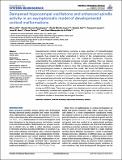Por favor, use este identificador para citar o enlazar a este item:
http://hdl.handle.net/10261/153169COMPARTIR / EXPORTAR:
 SHARE SHARE
 CORE
BASE CORE
BASE
|
|
| Visualizar otros formatos: MARC | Dublin Core | RDF | ORE | MODS | METS | DIDL | DATACITE | |

| Título: | Dampened hippocampal oscillations and enhanced spindle activity in an asymptomatic model of developmental cortical malformations |
Autor: | Cid Ledesma, Elena CSIC ORCID; Gómez-Domínguez, Daniel CSIC ORCID; Martin-Lopez, David; Gal, Beatriz CSIC ORCID; Laurent, François CSIC; Ibarz, Jose M.; Francis, Fiona; Menéndez de la Prida, Liset CSIC ORCID | Fecha de publicación: | 14-abr-2014 | Editor: | Frontiers Media | Citación: | Front. Syst. Neurosci. 8: 50 (2014) | Resumen: | Developmental cortical malformations comprise a large spectrum of histopathological brain abnormalities and syndromes. Their genetic, developmental and clinical complexity suggests they should be better understood in terms of the complementary action of independently timed perturbations (i.e., the multiple-hit hypothesis). However, understanding the underlying biological processes remains puzzling. Here we induced developmental cortical malformations in offspring, after intraventricular injection of methylazoxymethanol (MAM) in utero in mice. We combined extensive histological and electrophysiological studies to characterize the model. We found that MAM injections at E14 and E15 induced a range of cortical and hippocampal malformations resembling histological alterations of specific genetic mutations and transplacental mitotoxic agent injections. However, in contrast to most of these models, intraventricularly MAM-injected mice remained asymptomatic and showed no clear epilepsy-related phenotype as tested in long-term chronic recordings and with pharmacological manipulations. Instead, they exhibited a non-specific reduction of hippocampal-related brain oscillations (mostly in CA1); including theta, gamma and HFOs; and enhanced thalamocortical spindle activity during non-REM sleep. These data suggest that developmental cortical malformations do not necessarily correlate with epileptiform activity. We propose that the intraventricular in utero MAM approach exhibiting a range of rhythmopathies is a suitable model for multiple-hit studies of associated neurological disorders. | Versión del editor: | http://dx.doi.org/10.3389/fnsys.2014.00050 | URI: | http://hdl.handle.net/10261/153169 | DOI: | 10.3389/fnsys.2014.00050 | ISSN: | 1662-5137 |
| Aparece en las colecciones: | (IC) Artículos |
Ficheros en este ítem:
| Fichero | Descripción | Tamaño | Formato | |
|---|---|---|---|---|
| Dampened_hippocampal_oscillations.pdf | 2,02 MB | Adobe PDF |  Visualizar/Abrir |
CORE Recommender
PubMed Central
Citations
2
checked on 10-abr-2024
SCOPUSTM
Citations
5
checked on 19-abr-2024
Page view(s)
301
checked on 19-abr-2024
Download(s)
203
checked on 19-abr-2024

